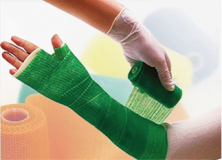 Getting a cast can be a rite of passage for many children, especially those who play sports (or those who decide to test their superpowers!) However, children are not simply small adults and the types of fractures and treatment given to children can vary widely from their adult counterparts.
Getting a cast can be a rite of passage for many children, especially those who play sports (or those who decide to test their superpowers!) However, children are not simply small adults and the types of fractures and treatment given to children can vary widely from their adult counterparts.
First, children’s bones are far more flexible than those of adults, and have a thicker covering, making them better able to absorb shock. Thus, in most cases, children experience “greenstick” fractures, named for the way the bone bends much like the green wood of a tree, and break only on one side. Another common break is called a “torus” fracture, where the bone can be buckled, twisted or weakened, but is not completely broken. Still, there are cases of “complete” fractures, where the bone breaks all way through, or “displaced” fractures, where the ends are separated or out of alignment, requiring that the bone be put back in its proper place.
The good news is that children have an amazing ability to heal. What might take months to heal for an adult, may take only weeks in a child before they are back in action, and more often than not, surgery is not necessary. Despite their aptness for a quick rebound, it is important to note that children are vulnerable to additional damage that does not occur in adults. Growth plate damage, or damage to the plates at the ends of the bone where new cells are quickly dividing, can cause the bone to grow at an angle or more slowly than the bones in the rest of the body. For this reason, it is important to monitor fractures carefully in the 12 to 18 months following an injury, to make sure no growth damage has occurred, and often children with fractures near the elbow need to see an orthopedic specialist.
So, what do you do when you suspect a broken bone? In many cases, you will see signs of swelling and your child will experience “point tenderness” in the specific location of the fracture. Inability or unwillingness to move the injured limb are also signs of a possible break. If you do suspect a fracture you should call purePEDIATRICS immediately, but until your child is seen by a doctor, it is important to do the following:
- Rest: prevent the child from using the limb
- Ice: use ice or a cold compress over the area for 20 minutes (careful not to harm the delicate skin of babies or toddlers)
- Compression: wrap limb with an elastic-type bandage to decrease swelling
- Elevation: keep limb raised above the level of the heart to prevent swelling
Once your child is examined, the doctor will probably take an X-ray to verify that the bone is in fact broken and better examine the fracture itself. Depending on the injury, your child may be given a cast or splint to hold the bone in the correct position while the bone is healing. In some cases, the doctor may need to place the bone back into its proper position, and may use a local anesthetic to minimize pain or discomfort. In more severe cases, surgically placed pins may be necessary.
The good news is that casting the limb usually means rapid pain relief, but if your child experiences any increase in pain, numbness, or pale or blue fingers or toes contact your doctor immediately. These are all signs that the cast may be too tight or improperly placed, and if left uncorrected could lead to permanent nerve, muscle or blood vessel damage. It is also important to keep your child’s cast clean and dry. If the cast becomes soggy or loose, the cast won’t do its job of holding the bone in position so that it can properly mend.
So, for all those parents of Houston’s active children (or superheroes!) out there, it is important to follow your doctor’s orders. When it comes to treating your child’s broken bones, a little extra TLC can go a long way, and odds are they won’t be sitting on the sidelines for long!





Find us in: